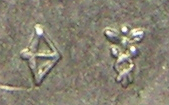Privy mark
This article needs additional citations for verification. (December 2009) |

A privy mark was originally a small mark or differentiation in the design of a coin for the purpose of identifying the mint, moneyer, some other aspect of the coin's origin, or to prevent counterfeiting. One of the first instances of a privy mark used as a counterfeit measure was during the 17th century in a plan proposed by Sir Edward Ford to mint farthings, halfpence and three-farthings.[1]
In modern times, the privy mark is used as a design and marketing feature to commemorate a special event or signify that the coin is part of a set. It is still sometimes used to signify the location or origin of where the coin was minted, but is then usually referred to as a mint mark.[2][unreliable source?] Some privy marked coins – such as the Canadian Silver Privy Marked Maple Leaf – may sell at a premium.
See also[]
References[]
- ^ "ANS Digital Library: Mark Newby's St. Patrick coinage". numismatics.org.
- ^ "Privy Marks & Mint Marks: Knowing the Difference | Bullion Exchanges". bullionexchanges.com.
| Wikimedia Commons has media related to Privy marks. |
- Numismatic terminology
- Currency production
- Coin stubs